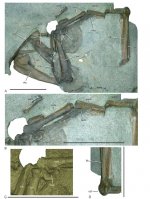Fred Ruhe
Well-known member

Gerald Mayr, Vanesa L. de Pietri, Leigh Love, Al A. Mannering, Joseph J. Bevitt and R. Paul Scofield, 2020
First Complete Wing of a Stem Group Sphenisciform from the Paleocene of New Zealand Sheds Light on the Evolution of the Penguin Flipper
Diversity 2020, 12(2), 46; https://doi.org/10.3390/d12020046
Abstract: https://www.mdpi.com/1424-2818/12/2/46
free pdf: https://www.mdpi.com/1424-2818/12/2/46/pdf
We describe a partial skeleton of a stem group penguin from the Waipara Greensand in New Zealand, which is tentatively assigned to Muriwaimanu tuatahi. The fossil includes the first complete wing of a Paleocene penguin and informs on previously unknown features of the mandible and tibiotarsus of small-sized Sphenisciformes from the Waipara Greensand. The wing is distinguished by important features from that of all geologically younger Sphenisciformes and documents an early stage in the evolution of wing-propelled diving in penguins. In particular, the wing of the new fossil exhibits a well-developed alular phalanx and the distal phalanges are not flattened. Because the wing phalanges resemble those of volant birds, we consider it likely that the wing feathers remained differentiated into functional categories and were not short and scale-like as they are in extant penguins. Even though the flippers of geologically younger penguins may favor survival in extremely cold climates, they are likely to have been shaped by hydrodynamic demands. Possible selective drivers include a diminished importance of the hindlimbs in subaquatic propulsion, new foraging strategies (the caudal end of the mandible of the new fossil distinctly differs from that of extant penguins), or increased predation by marine mammals.
Keywords: Aves; evolution; fossil birds; Muriwaimanu tuatahi; Sphenisciformes; wing-propelled diving
Enjoy,
Fred
First Complete Wing of a Stem Group Sphenisciform from the Paleocene of New Zealand Sheds Light on the Evolution of the Penguin Flipper
Diversity 2020, 12(2), 46; https://doi.org/10.3390/d12020046
Abstract: https://www.mdpi.com/1424-2818/12/2/46
free pdf: https://www.mdpi.com/1424-2818/12/2/46/pdf
We describe a partial skeleton of a stem group penguin from the Waipara Greensand in New Zealand, which is tentatively assigned to Muriwaimanu tuatahi. The fossil includes the first complete wing of a Paleocene penguin and informs on previously unknown features of the mandible and tibiotarsus of small-sized Sphenisciformes from the Waipara Greensand. The wing is distinguished by important features from that of all geologically younger Sphenisciformes and documents an early stage in the evolution of wing-propelled diving in penguins. In particular, the wing of the new fossil exhibits a well-developed alular phalanx and the distal phalanges are not flattened. Because the wing phalanges resemble those of volant birds, we consider it likely that the wing feathers remained differentiated into functional categories and were not short and scale-like as they are in extant penguins. Even though the flippers of geologically younger penguins may favor survival in extremely cold climates, they are likely to have been shaped by hydrodynamic demands. Possible selective drivers include a diminished importance of the hindlimbs in subaquatic propulsion, new foraging strategies (the caudal end of the mandible of the new fossil distinctly differs from that of extant penguins), or increased predation by marine mammals.
Keywords: Aves; evolution; fossil birds; Muriwaimanu tuatahi; Sphenisciformes; wing-propelled diving
Enjoy,
Fred




